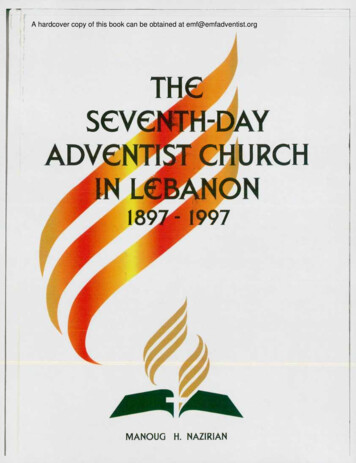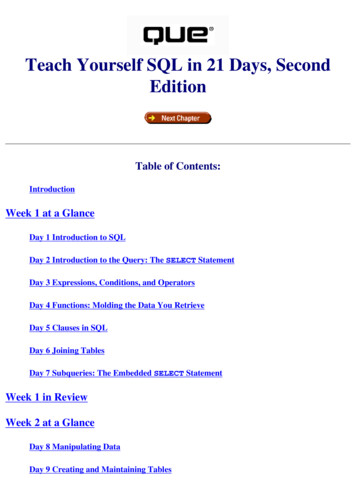
Transcription
A hardcover copy of this book can be obtained at emf@emfadventist.orgTHESEV H-DAYADVEN CHURCHON97MANOUG H. NAZIRIAN
THESEVENTH-DAYADVENTIST CHURCHIN LEBANON1897 - 1997ByMANOUG H. NAZIRIANPublishedbyThe East Mediterranean FieldofSeventh-day Adventists1999Beirut, Lebanon
DEDICATIONThis book is dedicated to all the nationaland expatriate employees and laity, whocompelled by the love of Christ, devotedthemselves to the proclamation of theAdvent Message in the ancient Biblicalrand of Lebanon in order ' to makeready a people for the Lord'.
T rTI T"TPageForeword6Preface7Lebanon in the Bible9Early Developments11Abraham La Rue's Initial Contact with Lebanon11H. P. Holser's Visit11L. R. Conradi's Survey of the Middle East Including Lebanon11Elias Zarub: Pioneer Preacher and Colporteur Won by a Lay Member 12Early Sabbath Keepers121908 - A Memorable Date12George Keough - Pioneer Missionary to Egypt12Walter Ising - Pioneer Missionary to Lebanon13Baptism of Ibrahim El Khalil, Shukry Nowfel and Bashir Hasso13The First Seventh-day Adventist Church in Lebanon13Henry Erzberger's Arrival14Far-reaching Effects of World War I14Resumption of Work in Mission Fields14Walter Ising Revisits Lebanon14Later Developments15Nils Zerne Reorganizes the Church15Persecution - A Blessing in Disguise15The Seventh-day Adventist Church in Lebanon After World War I16Change of Leadership16Seventh-day Adventist Pioneers16Pastor Shukry Nowfel: The First Lebanese Ordained Minister16Pastor Ibrahim El-Khalil18Hamad Elias Obeid18
Lebanon's Place in the Organizational Structures of the Seventh-dayAdventist Church19Seventh-day Adventist Churches and Institutions in LebanonAramoun Adventist SchoolAramoun Seventh-day Adventist Church20212225263033353639404245474851Armenian Adventist SchoolArmenian Seventh-day Adventist ChurchAshrafieh Seventh-day Adventist ChurchBeirut Adventist Church SchoolBishmezzine Adventist SchoolBishmezzine Seventh-day Adventist ChurchBoucherieh Adventist Secondary SchoolBoucherieh Seventh-day Adventist ChurchCollege Park ChurchMiddle East CollegeMouseitbeh Adventist Secondary SchoolMouseitbeh Seventh-day Adventist ChurchMiddle East PressVoice of Prophecy (Bible Coresspondance School)Physiotherapy Clinic5354Additional Developments Aimed At Expanding the MissionOutreach of the Church55Seventh-day Adventist Youth in Lebanon57The Sixteen Year Long Lebanese War (1975 - 1991)58Centennial Celebration of the SDA Church in Lebanon59Our Divine Mission and Commission68Presidents of the East Mediterranean Field in ChronologicalOrder (1909-1997)69Secretary - Treasurers of the East Mediterranean Fieldin Chronological order (1909-1997)73Memories74Key to Abbreviations79Directory of Employees80References96
F OREWORDElder Manoug Nazirian, an active Seventh-day Adventist retiree, and former churchadministrator and college president, in the Middle East, has rendered a commendableservice to the SDA Church in Lebanon in the preparation of a valuable resource materialthat deals with the historical development of the SDA Church over the past century(1897-1997) in the Republic of Lebanon. Much of this data was unknown andunpublished, to this day.It is fitting that the only Lebanese with such a wide and vast experience should haveundertaken this valuable task. The love of people and the positive contribution theymade to the building up of the SDA Church and its institutions is clearly evidenced inthis book.Elder Nazirian's work will hopefully inspire other nationals to take over where heleft off and build on the foundation that has been diligently laid. Many more questionswill have to be addressed in order to further enrich our understanding of the history ofthe SDA Church in Lebanon.A vital point needs here to occupy our attention, which is the drastic depletion ofchurch membership in Lebanon. This disturbing phenomenon is attributed to anumber of factors, one of which is the protracted Lebanese war (1975-1991) that hascaused mass emigration, mostly to the USA. As a result, the overall outreach programof the church has been hampered and it has contributed to a lack of sustained growth.In the light of this fact, it is incumbent upon us to face this very real problem with thedetermination to find a solution to it.We can take courage from the phenomenal growth of the SDA church in othercountries where God's people have been faced with insuperable difficulties, but theHoly Spirit through the ministry of dedicated workers and laity has accomplishedamazing things by bringing thousands of lost sheep into the safe fold of Christ. Surelywhat the Spirit of God has done elsewhere, He can also do for His church in Lebanon,provided we surrender all to Him, fully cooperate with Him, and equipped with Histransforming power we rise to the challenge of fulfilling our divine mission andcommission.It is the solemn responsibility of other national historians to dig deeper and to helpthe SDA Church in Lebanon to fully understand its past so that its future can be whatGod intends it to be.Claude Lombart, D.Min.East Mediterranean Field PresidentBeirut, November 10, 1998
The story of the Seventh-day Adventist Church in Lebanon (1897-1997) cannot befully related in this concise book. Hence, I opted to present in the ensuing pages aconcise summary of the origin and growth of the Seventh-day Adventist Church in thisancient Biblical land. I would also like to point out that in this book I have tried torecord the essential facts of the history of the SDA church in Lebanon without dulydwelling upon the philosophy of mission adopted and followed by our church leadersand administrators who with God's help established the church and operated it.Besides, I have not identified the various factors that have impeded the progress of thework. I intend to objectively deal with this timely issue in a separate article.In the research process I am indebted to the following sources for substantial help:Dr. Baldur Ed. Pfeiffer's valuable book entitled The European Seventh-day AdventistMission in the Middle East 1879-1939, Seventh-day Adventist Encyclopedia, Seventh-dayAdventist Yearbooks, East Mediterranean Field Service Records, Middle East Union and EastMediterranean Field Committee Minutes, Middle East College Pine Echoes, Mildred Olson'sMiddle East Program presented at Middle East Fellowship in the USA (April 4-7, 1997),The Middle East Messenger (official organ of the Middle East Union Mission of Seventh-dayAdventists, 1945-1970 issues), Impact (official organ of the Afro-Mideast Division ofSeventh-day Adventists, 1971-1977 issues), and personal interviews with SDAemployees and sustentees residing in Lebanon, as well as my own service in the churchfor over forty three years, that have provided information that is not availableelsewhere.I am also thankful to Claude Lombart, President of the East Mediterranean Field,Raja Farah, Head of the Religion Department at Middle East College, Nabil Mansour,Editor of the Middle East Press, for reading the manuscript and offering constructivecomments, and Jimmy Choufani, Director of Youth Ministries Department of theMiddle East Union and the East Mediterranean Field, for the clerical work.It is hoped that these pages will achieve a twofold objective:To refresh our minds on God's marvelous leadership in the history of theSeventh-day Adventist Church in Lebanon encouraging us to face the futurewith absolute confidence in the ultimate triumph of His truth.To lead us into an experience of wholehearted dedication and commitmentto God that will compel us to do our honest part in fulfilling Christ's commission(Mathew 28:18-20) in this generation.Manoug H. Nazirian
Cedar of Lebanon: symbol of spiritual growth,strength, and fortitude (Psalm 92:12)
LEBANONINTHE BIBLELebanon, a republic in the Middle East, is situated onthe Eastern Shore of the Mediterranean Sea. Its area is10,452 sq. km . It is bounded by Syria on the north and eastand by Israel on the south. Its population, composed ofChristians and Muslims, is estimated at 4.5 millionincluding the non-Lebanese residents. It is a member of theUnited Nations and the Arab League.Lebanon is mentioned sixty-eight times in the OldTestament, and the name Phoenicia (ancient name ofLebanon) occurs three times only in the New Testament.The inspired writers of the Old Testament books refer toLebanon for its natural beauty (Isaiah 35:1,2), for its snowand streams (Jeremiah 18:14), for its wild beasts, such aslions and leopards (2 Kings 14:9; Songs of Solomon 4:8),and for its majestic cedars and other trees - the fir, the pine,and the box (Songs of Solomon 5:15; Amos 2:9; Psalms104:16; 2 Kings 19:23; Isaiah 60:13). We learn from 1 Kings5:5-10 that King Solomon used timber of cedar fromLebanon to beautify the Lord's Temple in Jerusalem.Lebanon is noted for its important historic sites, such asthe rock inscriptions at the Dog River (Naher El-Kalb),Byblos (Biblical Gebel), Baalbeck, Tyre, Sidon, andZarephath, etc.Two inspired gospel writers, St. Matthew and St. Markmention that during His Galilean ministry (A.D. 29-30),Christ visited the region of Tyre and Sidon, where Herewarded the faith of a Syro-phoenician woman by healingher devil-possessed daughter (Matthew 15:21-28; Mark7:24-30).Furthermore, St. Luke tells us in Acts 21:3-6 that therewas a Christian church in Tyre in the apostolic period. Onhis way to Jerusalem, the apostle Paul visited this churchduring his third missionary journey (A.D. 53-58).There is ample evidence in the New Testament that theChristian churches that were established by Christ'sapostles believed in and preached the truth of the secondcoming of Jesus and kept the seventh-day Sabbath as God's.holy day of rest (John 14:1-3; Acts 1:11; Hebrews 9:28;Revelation 22:20; Luke 23:54-56; Acts 13:42-44, 16:13, 17:2,18:1-4). We do not know exactly how long the Seventh-dayAdventist Church in Tyre continued to shed its God-givenlight in Lebanon. But one who is acquainted with thecolorful history of Lebanon knows that there has alwaysbeen a strong Christian presence in this fair land from theapostolic period to the present time.Today, we believe that in divine providence when theright time arrived God motivated His dedicated servants tobring the Advent Message to the Middle East. Thus, it wasa century ago that the light of present truths specifically forthese last days began shining brightly in Lebanon.
11The seventh-Day Adventist Church In LebanonEARLY DEVELOPMENTSAbraham La Rue's Initial Contactwith LebanonResponding to Christ's global commissionto carry the Good News of salvation "toevery nation, and kindred, and tongueand people" (Revelation 14:6), Abraham La Rue,an American self-supporting pioneer laymissionary to China, paid a short visit to Beirutin 1897 and left some truth-filled literature herewith the purpose of acquainting the Lebanesewith the "present truth" (2 Peter 1:12) 1. Only ineternity will we know the ultimate result of thisact of sowing seeds of truth through thepowerful agency of the printed page.Abraham La Rue, self-supporting lay missionary to ChinaAdvent Message. In harmony with this plan,L. R. Conradi, a German-American, thenpresident of the European Seventh-dayAdventist Mission, made a tour of the MiddleEast in 1901 to see how the mission outreach ofthe church can be best served in this importantgeographical area. During his tour he passedthrough Beirut where he met with Dr. DanielBliss, President of the Protestant College of Syria,precursor of the American University of Beirut(AUB). Elder Conradi was shown the institutionwhere he had the opportunity to obtain firsthandinformation on the American Mission from theAmerican Missionaries who were serving at thefaculty. He also visited the press of the AmericanTract Association where literature and Bibleswere being printed in Arabic. His survey of theMiddle Eastern countries in general and ofLebanon in particular led him to the conclusionthat Seventh-day Adventists should alsoestablish their headquarters for the Middle Eastin Beirut3 . His farsightedness was vindicatedafter 1939 when American expatriate workerstook over the leadership of the Seventh-dayAdventist Church in the Middle East. For somethirty years the headquarters for the Middle EastDivision and the Afro-Mideast Division and theMiddle East Union were located in Beirut, capitalcity of the Republic of Lebanon.H. P. Holser's VisitFollowing this germinal development, H. P.Holser of the Central European Conferencevisited Lebanon in 1898 with a view to makingplans for publishing books and tracts in theArabic language. 2L. R. Conradi's Survey of the MiddleEast Including LebanonThen the European Seventh-day AdventistMission with its headquarters in Darmstadt,Germany, felt the sacred urge to enter theMiddle East including Lebanon with theL.R. Conradi,Director of theEuropean Seventhday AdventistMission
12Elias Zarub: Pioneer Preacher andColporteur Won by a Lay MemberIn recounting the origin and progress ofthe Seventh-day Adventist Church inLebanon, special recognition is to be given tothose committed lay persons who wereeffectively used by the Holy Spirit inbringing God's last warning and savingmessage to Lebanon - land of the worldfamous cedar trees. One of those faithful laypersons was a Lebanese (name not available)who while residing in the United States ofAmerica had accepted the advent message.In 1902, he visited his parents in Lebanonbringing a copy of the book Bible Readings.With the help of this good book, hesucceeded in convincing the Protestantminister named Zarub in his town insouthern Lebanon of the Sabbath truth. Notknowing that there were Seventh-dayAdventists in the Middle East, Zarub visitedBerrien Springs (Michigan, U.S.A.) where hespent six months with our church leaderswho taught him the message more fully. 4With a burden for the Master's serviceheavily resting upon his heart he returned toLebanon in 1903 as a worker to share his Godgiven faith with his fellow nationals. Uponhis arrival he made contact with John HarryKrum, the German-American colporteur itinerant - preacher - missionary who servedin Palestine at that times. Krum came toLebanon and teamed up with Zarub andtogether they toured the villages in southernLebanon as literature evangelists placingAdventist publications in the homes ofpeople. Soon it became apparent that Zarubwas determined to follow an independentcourse. He printed his own literature on theSeventh-day Adventist church and itsmessage and baptized a few followers withthe aim of establishing an indigenous MiddleEastern church according to local culture andcustoms. His independence was interruptedby the arrival of Walter K. Ising fromGermany, whose idea of church organizationand unity was incompatible with Zarub'sconcept of developing the work. As a resultZarub bid farewell to his town Alma El-Shaaband immigrated with his family to Brazilwhere he continued to be a loyal activechurch member. 6Early Sabbath KeepersDuring the years 1903-1908, before wehad any organized work in Lebanon,Sabbath keepers were reported in Malakanear Beirut, and in Deir Demas near mountHermon, possibly converts of Elias Zarub;also in Beirut a German masseur namedHaussman and his wife, a nurse from Baselsanitarium, who were engaged in privatehealth work. Haussman was a convert ofJohn Harry Krum in Jaffa, Palestine. Whenin 1905 W. H. Wakeman, superintendent ofthe Egyptian Mission (son-in-law ofConradi), visited Lebanon, he baptized awoman named Anistas Khoury, a teacherfrom Schwayfat, who had vacationed inNew York five years earlier and had learnedof the Sabbath truth. He also baptized aformer Catholic priest in the village ofMagdouchy near Sidon. 71908 A Memorable Date-The year 1908 is a very significant date inthe colorful history of the Seventh-dayAdventist church in the Middle East. In thisyear two spirit-filled missionaries, GeorgeKeough from Ireland and Walter R. Ising fromGermany arrived in Egypt and Lebanonrespectively.George Keough - Pioneer Missionaryto EgyptAs a result of living and working amongthe fallahin (farmers) of the Nile in UpperEgypt in 1912 Keough's self-sacrificingministry, blessed by Heaven, was richlyrewarded when 24 fellahin - 17 men and 7women from Ben Adi were baptized thusforming the first Arabic speaking Seventhday Adventist church in Egypt. These upperEgyptian Christian farmers had with thehelp of the Holy Spirit discovered the Bibletruth of the Sabbath and had faithfully beenkeeping it for some years prior to the arrivalof Keough. This Phenomenal success inevangelism paved the way for the rapidgrowth of the Seventh-day Adventismthroughout Egypt.
13Walter Ising - Pioneer Missionaryto LebanonAs regards Ising, he was of German-Americanbackground who while living in the UnitedStates as an emigrant had joined the Seventh-dayAdventist church there. Upon his return to hisnative land Germany, Conradi chose him as hispersonal secretary and associate. After heworked with Conradi for a while and becameacquainted with the denomination and its modeof operations in Europe, he was sent by Conradito Lebanon in order to stress the indispensabilityof evangelism in building up the Lord's cause.Thus, a mission center under Ising's directionwas established in Beirut. 8Walter Ising,pioneermissionary toLebanonIn 1909 Ising was appointed as head of theSyrian-Egyptian Mission that consisted of Syria,Lebanon, Palestine, Egypt, Mesopotamia (Iraq),Arabia and Egyptian Sudan with itsheadquarters in Beirut. There were 7 or 8 churchmembers in Lebanon at that time but they werenot yet united in an organized church. 9While Ising was directing the work inLebanon early in 1910, Tigran Zachary, the firstArmenian dedicated colporteur, a convert ofTheodore Anthony-Tzadour Baharian of Turkey,proclaimed the truth of the second advent and ofthe Sabbath in Lebanon through the printedpage.10 Then he was joined by Michael Ghafaryand together they sold Seventh-day Adventistpublications in the major mountain villages andtowns. It is worth mentioning that Ising was oneof the very few Seventh-day Adventistmissionaries to the Middle East who not onlybelieved that mastering the Arabic language wasimperative for doing effective evangelism but heapplied himself to learning Arabic at theProtestant Center in the mountains.After one year of intensive study he renteda home near the Syrian Protestant College(now AUB) in Ras Beirut and began his publicministry among the indigenous population. 11Baptism of Ibrahim El-Khalil, ShukryNowfel and Bashir HassoThrough aggressive personal work and withGod's blessing Ising succeeded in establishing agood rapport with a group of students from theSyrian Protestant College some of whom begantaking regular Bible studies in his home. For twoyears he prayed earnestly and labored untiringlyuntil 1911, when he was able to baptize fivepersons including Ibrahim El-Khalil, ShukryNowfel and Bashir Hasso. 12 It is interesting tonote that Ibrahim El-Khalil was baptized in thebrook Cherith where Elijah was fed by ravens.He was a Kurdish Moslem from Turkey whobecame a pioneer minister in Palestine, Lebanon,and Syria. Shukry Nowfel was a Lebanese whoalso became a pioneer gospel minister andeffectively served in Lebanon and Syria. As forBashir Hasso, he became the pioneer layman whotook the advent message to his homeland Iraq.The First Seventh-day AdventistChurch in LebanonIt is most gratifying to know that the firstSeventh-day Adventist Church in Beirut wasorganized under Ising's leadership in 19081911. Its membership consisted of 13members, 7 Arabs, 5 Germans, and 1Armenian. These earliest converts joined thechurch out of love for the truth and not forsecuring denominational employment becausethe church had no institutions then. 13While Ising passionately endeavored toexpand his mission outreach in Beirut, greaterresponsibilities were assigned to him. Thecentral European Mission under Conradiappointed him as President of the Middle EastMission that was composed of Egypt, Palestine,Mesopotamia (Iraq), Syria, and Lebanon. Thusheavy administrative work prevented Ising fromstrengthening the newly established church inBeirut and deepening its outreach there.14
14Henry Erzberger's ArrivalIn 1913 Ising spent 9 months in Iraq trying togain a foothold there like he had done inLebanon. During his absence from Lebanonthree nationals - Ibrahim El-Khalil, ShukryNawfel and Dikran Zachary worked in Lebanon.In 1914 they were joined by Henry Erzbergerfrom Switzerland who directed the affairs of thechurch in Lebanon and remained in the MiddleEast throughout World War I. At this timechurch members held Sabbath services inBhamdoun in the mountains and at Erzberger'shome in Ras Beirut. 15Far-Reaching Effectsof World War IWorld War I had far reaching effects on theoverall outreach mission of the church in theMiddle East. Most missionaries who wereserving in different countries of the MiddleEast, together with their German churchmembers returned to Europe for safetyreasons. In 1915, the second year of the war,the Beirut Seventh-day Adventist church had10 members. Like the Seventh-day Adventistexpatriates who returned to Europe, the Arabmembers likewise went back to their homes inSyria and Iraq where each member kept hisfaith and shared it with his fellow-nativeswithout church fellowship and pastoral care.While Ising was in Egypt (he had theheadquarters transferred to Egypt) he wasinterned by the British forces and taken to aprison-of-war camp in Malta where he stayedf9r the next five years. The remaining fewchurch members in Lebanon were taken careof by Ibrahim El-Khalil who retainedcommunication with the Armenian Seventhday Adventist Mission in Istanbul that wasunder the leadership of Elder TzadourBaharian.As for Henry Erzberger, the Swissmissionary, who tried to stay behind and carryon the work in Lebanon, he first moved fromBeirut to the Lebanon mountains from wherehe went to Palestine in 1917 and finally endedup in Istanbul as the British forces approached.With Erzberger's departure, the Syrian Mission(composed of Syria, Lebanon and Cyprus) hadno director from 1918-1923. Thus, the warbrought the progress of the work in Lebanon toan abrupt halt. 16Resumption of Workin Mission FieldsDespite the fatal setback our missionoutreach suffered in Lebanon as a direct resultof World War I, Seventh-day Adventistleaders maintained their faith in God and inthe vision of the divine commission they werecalled to fulfill in the world. Therefore, in1920 an outstanding conference was held nearMagdelburg, Germany, where EuropeanSeventh-day Adventist leaders met withdelegates from the General Conference andobjectively reevaluated the situation in themission fields and approved plans to squarelyface the needs and challenges they presented.In this particular conference it was decided togive full moral and financial support to theCentral European Seventh-day AdventistMission to resume its work in the missionfields. 17Walter Ising Revisits LebanonIn 1920 Walter Ising was released from his61 month confinement in Malta and returnedto Germany where he was appointedsecretary of the Central European Seventhday Adventist Mission. At his firstopportunity he set out to survey thesituation in the Middle East but it was afterobtaining visas from the British and Frenchmandates in 1923 that he was able to travelto the region. 18When he revisited Lebanon, he happilydiscovered that some of the church membershe had baptized and who had been leftwithout pastoral care for several years, hadremained loyal throughout the tragic war.This brought great encouragement to hisheart. Two of his earliest converts IbrahimEl-Khalil and Shukry Nowfel who becameleading national gospel ministers, hadcourageously held aloft the torch of truth inLebanon during his long absence, and BashirHasso who had returned to Iraq was servingas an active elder of the Seventh-dayAdventist church in Mosul.19-
15LATER DEVELOPMENTSNils Zerne Reorganizes the ChurchAfter Ising returned to Europemissionaries were again recruited from thecontinent and sent over to fill a number ofvacant posts in the Middle East. One ofthese dedicated missionaries was Nils Zernefrom Switzerland. When he arrived in Beirutin 1923, he vigorously set out to reconstructthe work and to reorganize the church usingthe remaining few faithful members as thenucleus. 20Persecution: A Blessing in DisguiseDown through the ages the history of thechurch has shown that persecution andadverse circumstances encountered byGod's trusting and truth-loving people havebeen a blessing in disguise for His cause.They have substantially contributed to theprogress of the gospel work and havepurified the church. This proved to be truein the case of the Seventh-day Adventistchurch in Lebanon as well.In 1921 Nazareth Ohanian, an ArmenianSeventh-day Adventist from the city ofAdana, Turkey, (Mrs. Sella Nazirian'sgrandfather) settled in Beirut. Then in 1923ten additional Armenian Seventh-dayAdventists refugees from Turkey arrived inBeirut21 . They were the converts of TzadourBaharian, Diran Cherakian and TheodoreAnthony. Among the Armenian refugeeswere Sarkis Yerganian (Ara Yerganian'sfather) and Minas Hamalian (the Hamalians'grandfather). The arrival of these ArmenianSeventh-day Adventist members, who hadsurvived the Turkish persecutions andmassacres, not only bolstered the dwindledand scattered membership of our church inLebanon, but also formed the beginning ofthe Armenian Seventh-day Adventist churchin Beirut.Theodore Anthony (left): TheGreek lay member whointroduced the Advent messageinto Turkey in 1889. TzadourBaharian (right): TheodoreAnthony's first convert inTurkey, the first ordained SDAminister in the Middle East,President of the ArmenianMission in Turkey, martyred inTurkey. Their Armenian convertsbecame the nucleus of theArmenian SDA church inLebanon.
16The Seventh day Adventist Churchin Lebanon after World War I-After World War I, when the Mandate Forcesallowed Germans to travel in the Middle East,the Central European Division organized theEgypt-Syria Mission in 1923, which in 1927 wasrenamed as Arabic Union Mission with itsheadquarters in Cairo, Egypt. George Keoughwas appointed as its president. He directed thework in the Middle East from Cairo until 1929when Walter Ising joined the mission in theMiddle East again. From 1929 to 1942 WalterIsing and George Keough took shifts in theleadership in the Middle East.During the 1920s, especially after 1923, NilsZerne, Shukry Nowfel, Ibrahim El-Khalil,Stanley Bull, Wilhelm Lesovski and his wifeCharlotte and Walter Ising carried on the workin Lebanon. It is intresting to note that theGhazal Brothers - Chamoun, Melki, Ibrahim,and Najib - were baptized by Nils Zerne in theBeirut river (Nahr Beirut) in 1926 and after twoyears their wives followed suit. The Lesovskisserved as teachers at Mouseithbeh School in1929. Then, they were transferred to Syriawhere they founded the first Seventh-dayAdventist Church with 12 members inDamascus. One of Lesovski's converts wasFaris Dow, a Lebanese, who as a laymanserved on the Syrian Mission Committee. 22Change of LeadershipIt should be borne in mind that from 18791939 the European missionaries directed andsupported the mission of the Seventh-dayAdventist Church in the Arab lands. But whenWorld War II broke out in 1939, they returnedto their respective homelands in Europe andthe leadership of the Seventh-day Adventistmission in the Middle East was taken over byAmerican expatriate workers. 23During the period extending from 18791939 our dedicated European missionaries(especially after Walter Ising's arrival inLebanon in 1908) with a handful nationalpastors and lay members served withunstilted faith and energy and succeeded insetting the mission of the church on apermanent footing in the Syrian Mission thatcomprised Syria, Lebanon and Cyprus.It is interesting to note that when theEuropean missionaries left the Middle Eastthere were 16 churches and 420 members inthe Arabic Union Mission. The Syrian Missionhad two churches and 85 members. 24Seventh day Adventist Pioneers-The lives and ministry of Seventh-dayAdventist pioneers national and expatriatewere characterized by total commitmentwithout reservations. Their love for Christ andHis church compelled them to serveunconditionally. Their supreme goal in lifewas to glorify God and advance His cause onearth. Winning souls for the kingdom ofheaven dictated all their plans and actions.They were on the King's business in seasonand out of season. They proclaimed theirunique message with a sense of urgency. Forthem the Church, God's family, was the mostprecious object in the world. They patientlyand joyfully bore sufferings for the sake of thechurch (Col. 1:24). They refrained from doinganything that tended to erode the unity of thechurch and mar its fair reputation. Only onething mattered to them - success of the churchin revealing God's love to the world andfulfilling its global mission with the purpose ofhastening the coming of Jesus.--Honesty demands that we admit the factthat the Seventh-day Adventist Church inLebanon owes its existence to God'stransforming grace that flowed to the worldthrough the Christ-centered lives and ministryof our pioneers.As we consider our pioneers today, let usask ourselves the question - Do we have thekind of devotion to God's cause that they had?Pastor Shukry Nowfel: The FirstLebanese Ordained MinisterPastor Shukry Nowfel was one of ourpioneer ministers who rendered more than 50years of outstanding service for the Seventhday Adventist Church in the Middle East. As ayoung man after attending the NationalSchool in Souk-El Gharb near his home, heentered the American University of Beirut.There he came in contact with the German
17language were such that the sermons hepreached proved an inspiration to youngpeople and old.PastorShukryNowfel, thefirstLebaneseordainedministermissionary Walter R. Ising who taught him the"p
Seventh-day Adventist Churches and Institutions in Lebanon 20 . Pfeiffer's valuable book entitled . The European Seventh-day Adventist Mission in the Middle East 1879-1939, Seventh-day Adventist Encyclopedia,
![Welcome [dashdiet.me]](/img/17/30-day-weight-loss-journal.jpg)









